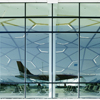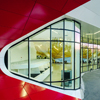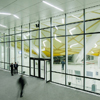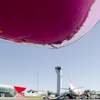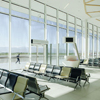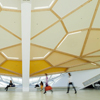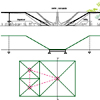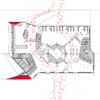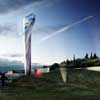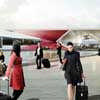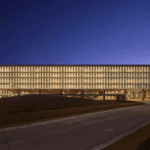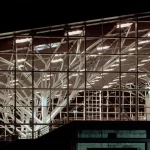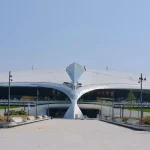Kutaisi Airport Georgia, Air Traffic Control Tower Images, Architect, Project Design
Kutaisi Airport, Georgia Building
Air Terminal Development design by Ben van Berkel / UNStudio, The Netherlands
13 Nov 2013
Kutaisi ‘King David the Builder’ International Airport, Georgia, 2011-2013
Design: UNStudio

photograph © Nakanimamasakhlisi
Kutaisi Airport Building
In recent years Georgia has undergone considerable development and as a result has moved its Parliament from the capital Tbilisi to the city of Kutaisi, a city which is also home to a large university and student population. Following the cessation of heavy industry exports to Russia, the city experienced a difficult economic period.
The Government of Georgia therefore decided to actively undertake an extensive regeneration of Kutaisi, not least by relocating the country’s seat of parliament and building a new international airport; an airport which also provides access to region to the growing numbers of tourists who have recently been discovering this young state in the Caucasus. The government of Georgia additionally wanted to reduce the cost of flights to the region, thereby not only making the city more accessible for tourists, but also for the students of Kutaisi University. Kutaisi International Airport is therefore designed to serve domestic and international flights for use by tourists, students, national politicians and international diplomats.
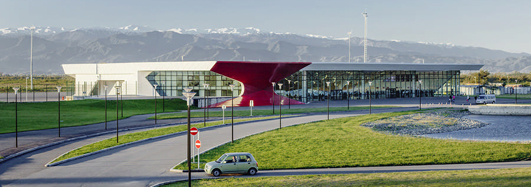
photograph © Nakanimamasakhlisi
UNStudio’s design for this new international airport comprises the full airport development, including a revision of the runway, the master plan for the landscape and planned future development thereof, the terminal building, offices, a meteorological station and the air traffic control tower. Regulations for the airport were strict and comprised of a mix of European and Georgian standards, including earthquake zoning 8 requirements.
The design for the new airport incorporates both Georgia’s historic landscape and its architecture. In Georgia public buildings and private houses employ their entrance lobbies as showcases for their individual identities. In the design for the new airport UNStudio embraces this architectural concept in order to manifest Georgia’s young and dynamic democracy, along with its rapid development as a main crossing point in the region. Georgia is located on a crossroads of rich cultures, with a history of travellers passing through the Caucasus or arriving from the Black Sea. The airport is therefore designed to form a foyer to the city; an open and welcoming gesture.
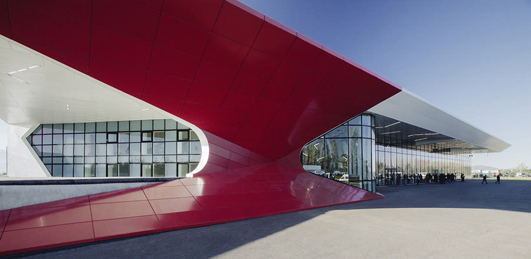
photograph © Nakanimamasakhlisi
Specific attention was paid in the design to the experience of the traveller. The more typical pre-flight ‘conveyor belt’ experience of the passenger typically pays little regard to the joy of travelling, to the social and experiential component of travel. The design for Kutaisi International Airport aims to replace this sense of mechanisation with the reintroduction of a sense of joy in the travel experience.
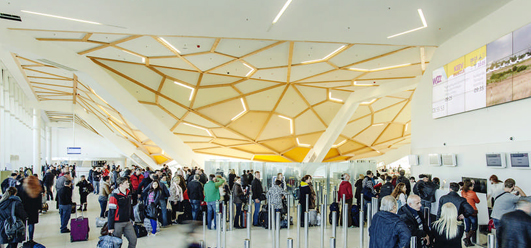
photograph © Nakanimamasakhlisi
The architecture of the terminal refers to a gateway, in which a clear structural layout creates an all-encompassing and protective volume. Both the exterior corner detail – which functions as a crossing-point and point of recognition – and the so called umbrella structure within the terminal building – which operates as a roundabout for passenger flows – operate as the two main architectural details around which all of the airport functions are organised. The umbrella further guarantees views from the terminal plaza to the apron and to the Caucasus on the horizon and vice versa. The central point in the umbrella is an exterior patio which is used for departing passengers. The transparent space around this central area is designed to ensure that flows of passengers are smooth and that departure and arrival flows do not coincide. The design organises the logistical processes, provides optimal security and ensures that the traveller has sufficient space to circulate comfortably. Serving as a lobby to Georgia, the terminal will in addition operate as a café and art gallery, displaying works by young Georgian artists and thereby presenting a further identifier of contemporary Georgian culture.
The 55m high Air Traffic Control Tower and its supporting office/operational building is designed to complement the design of the terminal. The tower’s strong appearance makes it a beacon of the airport and surrounding area. The traffic control cabin on the top level forms the focal point of the tower, with a 360 degrees view on the surrounding landscape. A spacious and comfortable interior ensures a workspace for 4-8 operators with optimal concentration. The exterior of the tower is clad with a perforated skin on a concrete core to use wind for ventilation purposes. LED Light in-between the skin and the core enhance the beacon effect of the tower at dusk and dawn by changing colour whenever there is a fluctuation in wind speed. This interactive element thus creates a visual sense of recognition and a feeling of ‘coming home’ for both travelers and those returning to the city respectively.
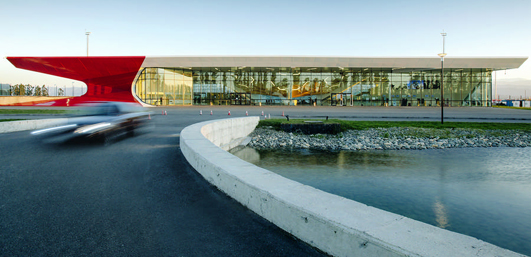
photograph © Nakanimamasakhlisi
The design for the new airport incorporates numerous sustainable elements. The previous structure of an existing office building has been reused. A large onsite underground source of natural water provides the basis for the reduction of energy consumption through concrete core activation and use for sprinkler basins. The floors of both the terminal and the traffic control tower will utilise this water for maintaining a regulated temperature in the two volumes. In the terminal building cantilevered roofs provide sun shading on south and southwest zones. A hybrid low pressure ventilation system is integrated into the terminal’s main structure and there is a grey water collection system in the floor underneath the terminal building. A future aim is to present Kutaisi airport as Georgia’s first airport to incorporate a strict segregation of waste and establish a recycling system which could be further implemented into new and existing projects in Georgia.
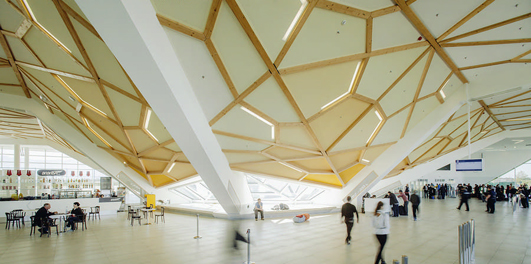
photograph © Nakanimamasakhlisi
The design for the airport further incorporates the potential for an expansion to double its size and capacity, should this prove necessary in the future.
The project was designed and constructed in two years, under lead consultancy of UNStudio, with the airport already having begun operations by September 2012. Both design and construction saw the involvement of numerous local and international companies, with openness and knowledge sharing proving to be essential to fulfilling the tight schedule. The steel structure of the terminal – produced and shipped from Hungary – recently won a European Steel Design Award.
Kutaisi International Airport will become a central hub, with up to one million travelers targeted in 2014-2015. Actual figures for the airport show 30 flights per week increasing in spring 2014 to 40, by which time direct flights from Western Europe to Kutaisi will also be possible.
Kutaisi ‘King David the Builder’ International Airport Georgia – Building Information
Title: Kutaisi ‘King David the Builder’ International Airport, Georgia, 2011-2013
Client: master plan and terminal: United Airports of Georgia LLC
Client: Air Traffic Control Tower, offices and meteorological building: Sakaeronavigatsia Ltd.
Location: Kutaisi, Georgia
Building surface: terminal 4,500m2, Control Tower and offices 1,800m2
Height Air Traffic Control Tower: 55m
Building site: 12,000 m2
Programme: International Airport Terminal, Air Traffic Control Tower and Offices for Navigation
Timing: Concept Design 2011, design development and construction 2012-2013
Status: Completed
Credits
UNStudio: Ben van Berkel, Caroline Bos, Gerard Loozekoot with Frans van Vuure and Filippo Lodi, Roman Kristesiashvili, Tina Kortmann, Wendy van der Knijff, Kristoph Nowak, Machiel Wafelbakker, Gustav Fagerström, Thomas Harms, Deepak Jawahar, Nils Saprovskis, Patrik Noome
Advisors
Structural consultant: MTM kft. Budapest
MEP consultant: SMG-SISU kft. Budapest
Landscape: OR else
Airport planning; Arup Aviation, London
Sustainability; Arup, Amsterdam
Terminal advisor on interior & art; Inside Outside / Petra Blaisse
Light: Primo Exposures
Local architect: Studio ARCI, Tbilisi
Acoustics: SCENA akoestisch adviseurs
Wind-testing: Peutz
Cost and management; Davis Langdon, London
Visualisation; Moka Studio
Photographer; Nakaniamasakhlisi, Tbilisi
Kutaisi Airport Development images / information from Ben van Berkel / UNStudio
23 Nov 2011
Kutaisi Airport Building in Georgia
Ben van Berkel / UNStudio’s design for the new Kutaisi Airport officially presented yesterday by the President of Georgia, Mikheil Saakashvili
UNStudio’s design for the new Transfer Terminal and Air Traffic Control Tower for Kutaisi Airport was officially presented yesterday by the President of Georgia, Mikheil Saakashvili.
Georgian President Mikhail Saakashvili, who personally demolished one of the walls of the old airport yesterday announced, “We will build an international airport here, which will take aircraft from Munich, Rome, Baku and other cities as of next year.”
UNStudio has designed the new Kutaisi Airport which will serve domestic and international flights for use by international diplomats, national politicians and for tourism.
Georgia, a young state in the Caucasus which has undergone considerable development in recent years, is moving its Parliament from the capital Tbilisi to the city of Kutaisi. A new parliament building is currently under construction in Kutaisi and in 2012 the first parliamentary meeting will take place.
In recent years growing numbers of tourists have been discovering Georgia, a country with an ancient and engaging history. As a result there is increasing demand from airlines to fly to Georgia. By virtue of its geographical advantages and the nearby location of two of Georgia’s most important Unesco monuments, Kutaisi was selected as the destination for a new airport. The new Kutaisi airport will in addition provide an economic impulse to Georgia’s second city and its new seat of Parliament.
Ben van Berkel: “The design for the new terminal in Kutaisi focuses first and foremost on the experience of the traveller by creating an inviting, safe, transparent and user-friendly airport. The desire to provide for and communicate equally with both international visitors and the local community is paramount.”
UNStudio’s design for the new Kutaisi Airport incorporates both Georgia’s historic landscape and its architecture. In Georgia public buildings and private houses employ their entrance lobbies as showcases for their individual identities. In the design for the new airport UNStudio embraces this architectural concept in order to manifest Georgia’s young and dynamic democracy, along with its rapid development as a main crossing point in the region. Georgia is located on a crossroads of rich cultures, with a history of travellers passing through the Caucasus or arriving from the Black Sea.
Ben van Berkel: “It was particularly exciting for me to be able to design an airport which is not only linked to the new seat of parliament in Kutaisi, but which also creates an entrance condition which functions as a port for the international community. The airport presents a symbolic infrastructural gateway to Georgia and, from there, to the rest of the world.”
The 4,000 m2 terminal building will house a central arrivals hall, a check-in area with lounge, cafe and car rental facilities, three gates for departure with retail, cafes, a CIP lounge area and exterior garden, an arrival area with customs and offices for the border police and an administration area with staff rooms and press conference facilities.
The architecture of the terminal refers to a pavilion; a gateway, in which a clear structural layout creates an all encompassing and protective volume. The volume is structured around a central exterior space which is used for departing passengers. The transparent space around this central point is designed to ensure that flows of passengers are smooth and that departure and arrival flows do not coincide. These axes incorporate views from the plaza to the apron and to the Caucasus on the horizon. The design organises the logistical processes, provides optimal security and ensures that the traveler has sufficient space to circulate comfortably. Serving as a lobby to Georgia, the terminal could in addition operate as an art gallery, displaying works by Georgian artists and thereby presenting a further identifier of contemporary Georgian culture.
Kutaisi Airport gate – layout ; Kutaisi Airport ground floor plan:

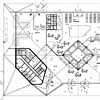
pictures © UNStudio
The 55m high, 300 m2 Air Traffic Control Tower is designed to compliment the design of the terminal. The traffic control cabin on the top level forms the focal point of the tower, with a spacious and comfortable interior ensuring a workspace of optimal concentration. 1,500 m2 of supporting office spaces are housed in a nearby building. The exterior of the tower is clad with a transparent skin with the potential to change color whenever there is a fluctuation in traffic. The Air Traffic Control Tower will function as a light beacon to the sky for the international airport, but also from the road to and from Georgia’s new parliamentary city Kutaisi.
Ben van Berkel: “The design for the new airport embraces the traveller by embodying the circumstance of the site. Moments of both leaving and returning are celebrated by the large span, open spaces and high ceiling of the terminal structure – reflecting the ways in which such gestures were employed in the great railway stations of the past.”
The design for the new airport aims to incorporate local and international sustainable elements. An onsite underground source of natural water provides the basis for the reduction of energy consumption through concrete core activation. The floors of both the Terminal and the ATCT will utilise this water for maintaining a regulated temperature in the two volumes.
In the Terminal building cantilevered roofs provide sun shading on south and southwest zones. A hybrid low pressure ventilation system will be integrated into the terminal’s main structure and there will be a grey water collection system in the floor underneath the terminal building. To further lower energy consumption there is the possibility to implement large areas of PV-cells on the roof surface. Kustaisi airport will be Georgia’s first airport to incorporate a strict segregation of waste. The aim is to establish a recycling system which could be further implemented into new and existing projects in Georgia.
Construction on the new Kutaisi Airport will begin in December 2011. The airport is scheduled to be operational in September 2012.
Kutaisi Airport organization ; Kutaisi Airport section:
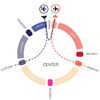
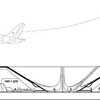
pictures © UNStudio
Air Traffic Control Tower + Offices – Building Information
Kutaisi Airport, Georgia, 2011 – 2012
Client Terminal: United Airports of Georgia LLC
Client Air Traffic Control Tower and Offices: SAKAERONAVIGATSIA Ltd.
Location: Kutaisi, Georgia
Building surface: Terminal 4.000m2, Control Tower and Offices 1.750m2
Height Air Traffic Control Tower: 55m.
Building site: 11.000 m2
Programme: International Airport Terminal, Air Traffic Control Tower and Offices for Navigation
Status: Concept Design 2011, Construction 2012
Credits
UNStudio: Ben van Berkel, Gerard Loozekoot with Frans van Vuure and Filippo Lodi, Tina Kortmann, Roman Kristesiashvili, Gustav Fagerström, Wendy van der Knijff, Machiel Wafelbakker, Deepak Jawahar
Kutaisi Airport Building images / information from Ben van Berkel / UNStudio
28 Nov 2017
Kutaisi International Airport Extension
Design: UNStudio
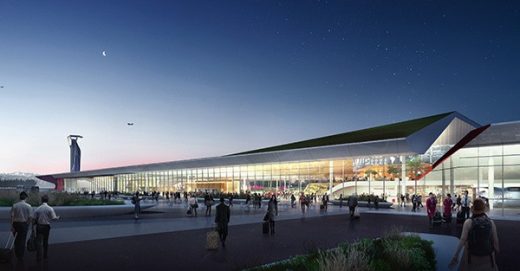
imjage : VA-render
Kutaisi International Airport Extension by UNStudio
Location: Kutaisi Airport, Georgia
Architecture in Georgia
Contemporary Georgia Architectural Projects
Georgia Architecture Designs – chronological list
Another Georgian airport building on e-architect:
New Airport Building in Mestia Georgia
Design: J. MAYER H. Architects

image from architects
Mestia Airport Building
A recent Georgian building on e-architect:
Sarpi Border Checkpoint
Design: J. MAYER H. Architects
Sarpi Checkpoint Georgia
Georgia Buildings – Selection
Fuel Station + Restaurant in Batumi, south west Georgia
Design: Giorgi Khmaladze (Khmaladze Architects)
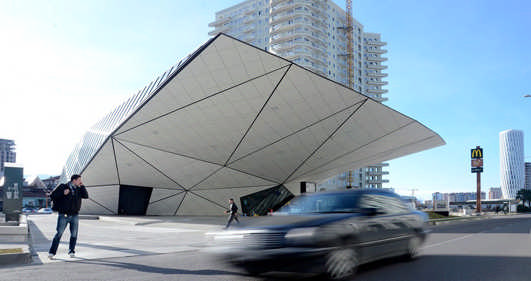
photo : Giorgi Khmaladze
Fuel Station Georgia
Lazika Municipality Building
Design: Architects of invention
Lazika Municipality Building
Comments / photos for the Kutaisi Airport Georgia – Air Traffic Control Tower page welcome

